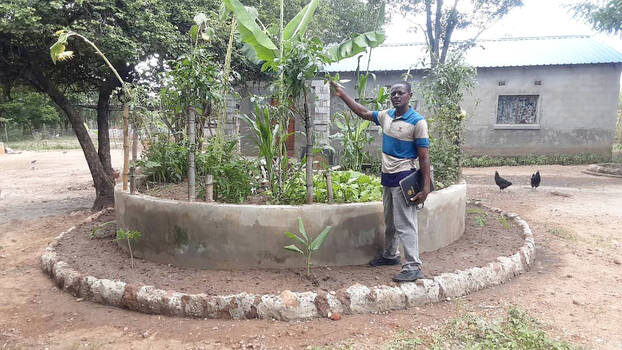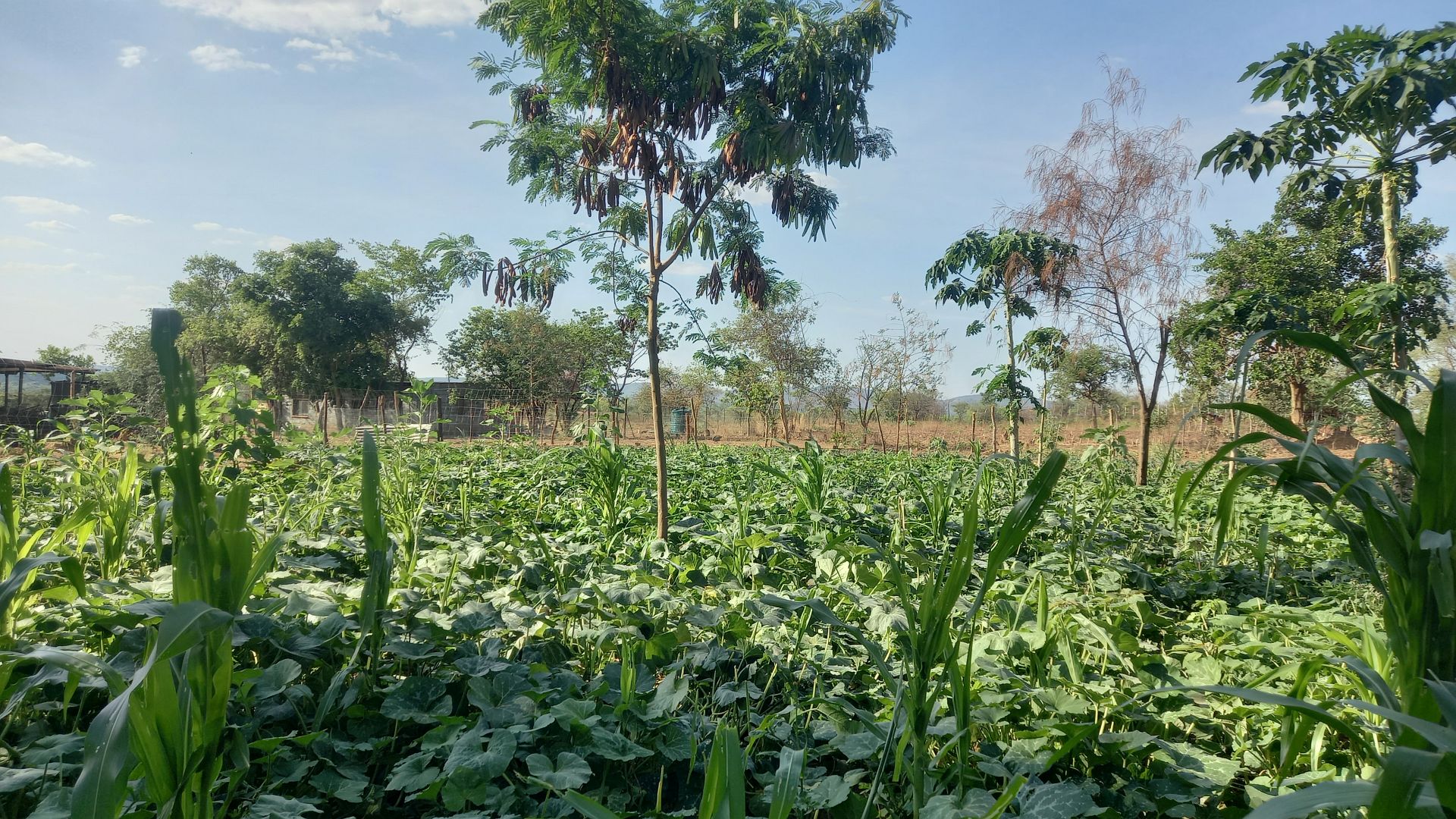
A concrete garden bed stands waist-high between two houses, while chickens peck here and there around the structure. A turkey and its two chicks lie in the shade beneath a mango tree nearby. A trapezoid-shaped structure forms the entrance to the round bed, and in the middle there’s a hole. From above, the whole thing looks like a keyhole, and that’s where this particular raised bed gets its name: the keyhole garden.
Kathrin Hartmann is a Munich-based journalist and author. She co-directed the 2018 film The Green Lie together with Werner Boote.
Royd Michelo climbs onto the soil which fills the raised bed to the brim, “not with soil”, Michelo corrects “but with Bokashi” — fermented kitchen compost. Right now, the bed is still empty, but a couple of weeks after my visit Michelo sends me pictures showing things sprouting on the bed, including a banana tree sapling.
Michelo has already shown thousands of farmers in Zambia how to plant and cultivate a bed like this. He is a small-scale food producer living in Chongwe, some 50 kilometres west of Lusaka, Zambia’s capital city. On his farm, Michelo grows more than fruit and vegetables — he also cultivates knowledge, futures, and climate protection.
Michelo works in agroecology and trains farmers in this method of farming: “On my farm I plant carrots, amaranth, salad, cabbage.” The vegetables in the keyhole bed are grown on different organic layers of soil. At the very bottom are maize crop biproducts, used to seal in the moisture. On top of this is organic material, soil, ash, and Bokashi. In the hole in the middle, Michelo places kitchen compost and grey water, creating a nutrient dense soil: “A garden like this should be near the kitchen, that way no resources are wasted.”
By following these methods, a raised bed of this sort can provide a family with vegetables for a whole year. It is also cheap: you don’t have to buy synthetic fertilizers or herbicides. This kind of agriculture also requires less water and does not require toxic pesticides. Instead, it combines traditional local knowledge with scientific research. Farmers work and experiment with what local resources are on offer. Instead of using licenced seeds, they propagate, develop, and exchange the seeds they harvest themselves, which are adapted to local conditions and offer a greater dietary diversity.
Agroecology is much more than farming with an organic label. As Oliver de Schutter, the former United Nations Special Rapporteur on the Right to Food, suggests: “It represents a certain way of looking at our relationship with nature. A growing social movement is forming around this view, promoting the direct exchange of information between farmers.”
Agroecology is a holistic concept that also encompasses food sovereignty, social and gender equality, health, education, prosperity, biodiversity, climate protection and adaptation, and changes to the local economy that benefit everyone. In short, it is a counter-concept to industrial agriculture, which is dominated by big agribusiness and characterized by mechanized farming, monocultures, cash crops for export, artificial irrigation, seed licensing, toxic pesticides, and synthetic fertilizers. Not only do these things make people sick, but they also cause conflicts over land, harm the climate, degrade the soil, and force famers into dependence on corporations and debt.
Sustainability Is Cheaper
More than ten years ago, Royd himself farmed in a conventional style in the South of Zambia. Then he enrolled in an agroecology training programme at Kasisi Agricultural Training Center (KATC). He was immediately convinced by the method:
It is so much cheaper! As a conventional farmer, I had to buy fertilizers, pesticides, licensed seeds, and plough the fields. As an agroecological farmer I harvest and sow my own seeds, I rotate crops to reduce pests, and in order to protect the soil, I only work it minimally.
Today, Michelo lives a stone’s throw from the training centre where he has worked as a teacher for eight years and has just been nominated as Zambia’s agroecology champion.
The late afternoon sun casts a golden light over the loamy soil and is reflected by the photovoltaic system on the roof of his house. “I was able to afford it after last season”, Michelo says casually as he leads me to the field that stretches behind his house, full of different plants growing lush and green from out of the red soil. He is proud to add: “On my five hectares of land, I grow 39 different crops.” Tomatoes, maize, manioc, pumpkin, hibiscus, beans, and papaya. He feeds the papaya leaves to the chickens, since they help against parasites.
In between these crops, Michelo has planted Gleditsia trees, which provide shade and keep the soil moist. “Do you see? This is what healthy, rich soil looks like”, Michelo asks, and I do see it, and the worms that populate it: “Synthetic fertilizer only feeds the plants, not the soil. But we need to feed the soil. The soil feeds the plants and the plants feed us.”
Three quarters of people living in rural Zambia live in poverty. Agriculture is their most important source of income.
Michelo carries an old water bottle with a black liquid in it: “This is my own fertilizer, it is made of molasses, ash, mulch, water, milk, and manure.” As he explains, “a litre of synthetic fertilizer costs 200 Zambian Kwacha.” That is around seven euro, and for that price, he could produce 200 litres of natural fertilizer. Teaching farmers how to make natural fertilizer is something he does often. Fertilizer prices have increased by 30 percent in Zambia since the Russian war in Ukraine. As a result, many people took interest in Michelo’s fertilizer lessons: “Many famers have learned their lesson and are interested in getting into agroecology but unfortunately, there is no government support to do so.”
Three quarters of people living in rural Zambia live in poverty. Agriculture is their most important source of income. Above all, monoculture maize is grown in Zambia. For more than 20 years, the Zambian government has subsidized hybrid seeds and synthetic fertilizers for small-scale food producers. In 2009, the Farmer Input Support Programme (FISP) was launched. The programme was intended to increase the yields and productivity of small-scale food producers, providing opportunities for them to grow into emerging farmers who no longer need state support. But this goal was never achieved. On the contrary, productivity stagnated, incomes fell, and FISP expenditure continued to rise.
Between 2015 and 2021, funding for the FISP programme accounted for between 33 and 80 percent of the overall agricultural budget. This primarily benefitted large agribusiness, while small-scale food producers were caught in a downward spiral, since the fertilizer they used contributed to soil degradation, meaning more fertilizer was needed to grow anything at all. As Michelo puts it, “FISP is killing farmers.”
Furthermore, there is not enough money in the agricultural budget for research or training farmers in agroecological methods. It has been scientifically proven that agroecology increases crop yields: in 2006 the University of Essex investigated 360 agroecology projects in 57 countries and found that yields grew by 79 percent in comparison to projects which relied on industrial agriculture. The University of Nebraska conducted a meta-study, which analysed almost 300 agricultural research papers, primarily focused on the Global South, and came to the same conclusion. Only agricultural multinationals are looking down their noses at these findings.
Agroecology Is More Than Organic
Now, the Zambian government will implement the Comprehensive Agriculture Transformation Support Programme (CATSP). This programme will focus on increasing production by means of the Green Revolution, making use of monocultures, synthetic fertilizers, hybrid seeds, pesticides, and cooperation with big agribusiness. FISP will remain available for poor farmers and will now include a credit system for synthetic fertilizer.
The colonial “Farmblocks” model will also be expanded on, which includes designating regions for large-scale agricultural enterprises to attract private-sector investors. The usual suspects are involved in this programme: the UN’s Food and Agriculture Organization (FAO), the Alliance for a Green Revolution in Africa (AGRA) founded by the Bill and Melinda Gates Foundation, the closely AGRA-related African Fertilizer and Agribusiness Partnership (AFAP), and the Deutsche Gesellschaft für Internationale Zusammenarbeit (GIZ).
Organizations like the Zambia Alliance for Agroecology and Biodiversity (ZAAB), which Michelo works with, are afraid the programme will lead to deforestation and displacement. Royd Michelo is racing against the clock. As he suggests, “The whole system could change if we could convince more people. But how can we get to the farmers when we’re not mobile?”, he asks.
Now all of Michelo’s neighbours farm, thanks to his programme, with agroecological methods.
The Ministry of Agriculture hires so-called “Extension Officers” to drive around on motorbikes and teach farmers about industrial farming methods. But people like Michelo, who teach agroecology do not have access to these forms of transportation. For this reason, Michelo began his agroecology revolution on his doorstep: “I run my own farming education programme here in the neighbourhood.” And it works like this:
My neighbour used to burn his field before tilling it. I tried to convince him of the benefits of agroecology. I said: “You don’t have to convert everything, try it on one hectare, I’ll help you, we’ll do it together. If you don’t like it, you don’t have to do it again.”
Michelo takes a dramatic pause and grins, “from that point on, there was no more fire on his fields.” Now all of Michelo’s neighbours farm, thanks to his programme, with agroecological methods. Last year alone, Michelo reports that he trained 3,050 farmers and taught in 15 cooperatives, 30 schools, and two colleges.
What does he tell people? “You should put up a sign on your farms that says agroecology so that people can see the difference and how well it works.”
This article first appeared in Der Freitag with the support of the Rosa Luxemburg Foundation’s Food Sovereignty Programme. Translated by Eve Richens and Hunter Bolin for Gegensatz Translation Collective.
